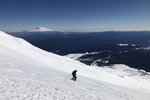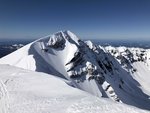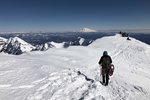



From the parking lot of the Marble Mountain Sno-Park, hemmed in by 10-foot snow walls kept at bay by a diligent plow, there’s little to indicate you’re a short distance from the summit of an iconic volcano. A thick forest encircles the pavement, and it’s only the gear-clad figures of climbers and skiers emerging from their cars that let you know this is the spot to start your ascent. As a gentle dawn bathes the clearing in light, you tug on your boots and follow snowy footprints into the woods.
In the summertime, Mount St. Helens plays host to all sorts of visitors, drive-by tourists, picnickers, hikers — and a few summit-bound hopefuls lucky enough to score climbing permits. In the winter, though, once most of the park’s visitor centers and gift shops are closed, the trails buried in snow, local mountain-lovers know their season is just beginning.
“Climbing in winter is a totally unique experience here compared to climbing in summer,” said Camille Stephens, recreation assistant at the Mount St. Helens National Volcanic Monument. “You see the mountain in a different light.”
It’s counterintuitive, perhaps, to suggest the best time to climb St. Helens is when wind chills at the summit can hover near zero, when the route requires a longer approach on less forgiving terrain. But if you reach the summit on a clear day, the jagged edges of the crater emerging from a blanket of white, with Rainier, Adams and Hood gleaming brilliant across the Cascades, it’s easy to understand why so many Washingtonians don’t wait for wildflower season to make for the slopes.
A winter climb of St. Helens is also a great opportunity to get a first taste of alpine-type climbing. With no dangerous crevasses and less avalanche-prone slopes than some other mountains, it doesn’t take a mountaineering veteran to reach the summit — just some preparation and an attentiveness to conditions.
“Mount St. Helens is considered a fairly introductory mountaineering route, because we don’t have the crevasses that you see on other mountains,” Stephens said.
That doesn’t mean it doesn’t take some planning. I’d originally planned to climb Mount St. Helens on a Valentine’s weekend date with my girlfriend Mandy, but we had to postpone when the Northwest Avalanche Center forecasted dangerous conditions in the area. Finally, on March 3, NWAC’s report looked much more promising, and the weather prediction was nothing but sunshine.
After begrudgingly rousing to our 4 a.m. alarm, we set off for the mountain, reaching the staging area just as the pre-dawn glow turned to full sunshine. We pulled on layers and jackets, loaded up our food and water for the day and strapped snowshoes to our packs. I fixed a pair of hiking crampons to my trail runners; Mandy opted for mountaineering boots. It wouldn’t matter much on this day — though we had ice axes, crampons and snowshoes, the well-trod path through the snow was climbable with just our shoes and trekking poles.
On firmer ice or deeper powder, our extra gear would have come in handy, and Stephens said it’s always best to be prepared for a wide range of conditions. For beginners especially, the best way to get ready is to take a class beforehand or sign up for a guide-led trip with a certified organization.
“If you don’t have experience or education in what to bring and how to prepare in an alpine environment, it’s really hard for people to know,” she said. “Going with a permitted outfitter and guide operation — usually with an outdoor education organization — that is the best way to ensure that you’re getting experience from a certified and trained educator.”
Stephens recommends that climbers bring snowshoes, crampons and ice axes, which can all be rented from local outfitters. Visitors should bring layers for bitterly cold conditions, enough to spend a night outside if an emergency situation arises. A balaclava or neck gaiter to keep out the wind is also a good idea, along with sunglasses and sunscreen for the blistering alpine glare.
For navigation, a map, compass and GPS app can all be necessary in different situations. A personal locator beacon, avalanche probe, and shovel are also important precautions. Of course, none of these tools are much good if you don’t know how to use them — and all of this may be starting to sound a bit daunting. That’s why Stephens recommends finding an outfitter, who can show you how to use the equipment and rent or provide much of it as part of an expedition. It’s also important to check in with the Northwest Avalanche Center and the Mount St. Helens Institute, which can help you determine if climbing conditions will be OK on the day you intend to summit.
As for the climb itself, it’s pretty straightforward. We followed some fellow climbers through a network of cross-country ski trails, tracking about two miles through the forest. We came to a station with climbing permits, filling out the self-issue form. After April 1, permits are strictly capped and issued through an online lottery — put in place to protect vegetation and the cultural resources of the Cowlitz Tribe. But in the winter, when the mountain’s buried in snow, there’s no quota, no luck of the draw. The only requirement is a willingness to trudge.
Once we broke out of the trees, the path quickly began climbing. We followed a narrow ridgeline between rows of volcanic rocks. Wind blew down from above, scouring the snow and pelting us with powder through every small opening in our clothing. Ducking behind a boulder, I put on ski goggles and pulled my neck gaiter up over my nose, then cinched my hood on tight. I drank some icy-cold water from my bottle and shivered as it ran down my throat.
The path pushed upward, and from here there was nothing to do but climb, as slow, steady, step-over-step ascent. Looking back, I saw the treeline starting to get smaller below and the spire of Mount Hood popping up to the south. As we got higher, Mount Adams appeared to the east, a nearby behemoth in comparison. Somewhere ahead, four miles or so was the summit, but we could only see where the climbers above us disappeared over the nearest undulation in the slope. Once we reached that crest, another slope would emerge, with another vanishing point where it met the horizon — and so on.
This climb over unbroken slopes of snow is what makes a winter ascent so different from the traditional route — and in some ways, perhaps easier.
“Once you’re above treeline, everything changes very dramatically,” Stephens said. “What you’re doing with your body is very different. In the summer, it’s full-body climbing experience, you’re climbing over those boulders and slogging through the pumice. In winter, you get more of what you would think of as your traditional mountaineering environment.”
Though it’s a steep, slow climb, the singular landscape allows you to get in a rhythm, to adjust your body’s pace to a steady level alongside your heart rate and breathing. We pushed ahead, not in a hurry, as overachievers who’d summited to see the sunrise made their way down around us. A few skiers zoomed by, covering in seconds terrain it had taken us an agonizing amount of time to climb.
As we got closer to the summit, the wind tapered off, and with a brilliant sun beating down and reflecting off the snow, we actually started to get warm. We took one long break just below the top to gather our breath for the final push, then made our way up. We followed tracks up and to the left, joining a group of climbers assembled along the rim of the crater. From our vantage point, the volcano’s jagged ridge sprawled each direction in a semicircle, like a giant amphitheater. Spirit Lake and its acres of floating timber shimmered blue to the north, with Mount Rainier’s dominant visage looming above it.
Under the heavy load of snow, sharp outcroppings of volcanic rock jutted out, shrugging off the white blanket. From the bowl of the crater, clouds of steam emerged amid the snow, a reminder of the forces that erupted from St. Helens in 1980. The mountain’s barren, gray summit, hollowed out by the explosion, has been compared to an ashtray, an apt but unflattering metaphor. That’s not the image you get in the winter, though.
“When the snow is completely melted off the mountain, it has an almost desert look to it with volcanic boulders and pumice,” Stephens said. “In winter, you see snow and ice on an active volcano that has heat and steam rising from the crater.”
We basked in the sun and views at the summit, staying well back of the cornices — danger zones where snow can overhang the solid rock by 30 feet and give way without warning. Poking holes in the ice layers that had formed in our bottles, we drank (and ate) plenty of water. After filling up with lunch, we began our descent, practically skipping down through the shin-deep powder. On one slope, we found a long imprint heading down in a line, left by the backsides of those who had descended before us. We followed their lead, taking a seat and whizzing down on our butts, whooping with delight. Of all the reasons to climb Mount St. Helens in the winter, the chance to glissade might be the most compelling one.
After about five and a half hours of climbing, the hike down went by in a breeze, taking just over three hours. Just because gravity’s on your side, though, doesn’t mean you should always plan for your descent to be faster. Stephens tells climbers to assume their return will take just as long as the climb up and set their turnaround time accordingly, as snow conditions and weather can have a major impact on how long it takes to get down. A sudden snowstorm could require careful GPS tracking just to keep to the route.
And regardless of how fit you are, and how much experience you have, you should budget an extended timeline for your climb.
“Plan your whole day around your climb,” Stephens said. “Don’t plan to be back by noon, don’t plan to be back by 2 p.m.”
Eventually, we made our way back into the trees and flatter terrain, finally reaching the parking lot with sore legs and sunburned faces. We piled into the car and nosed back down the mountain, heading for home.